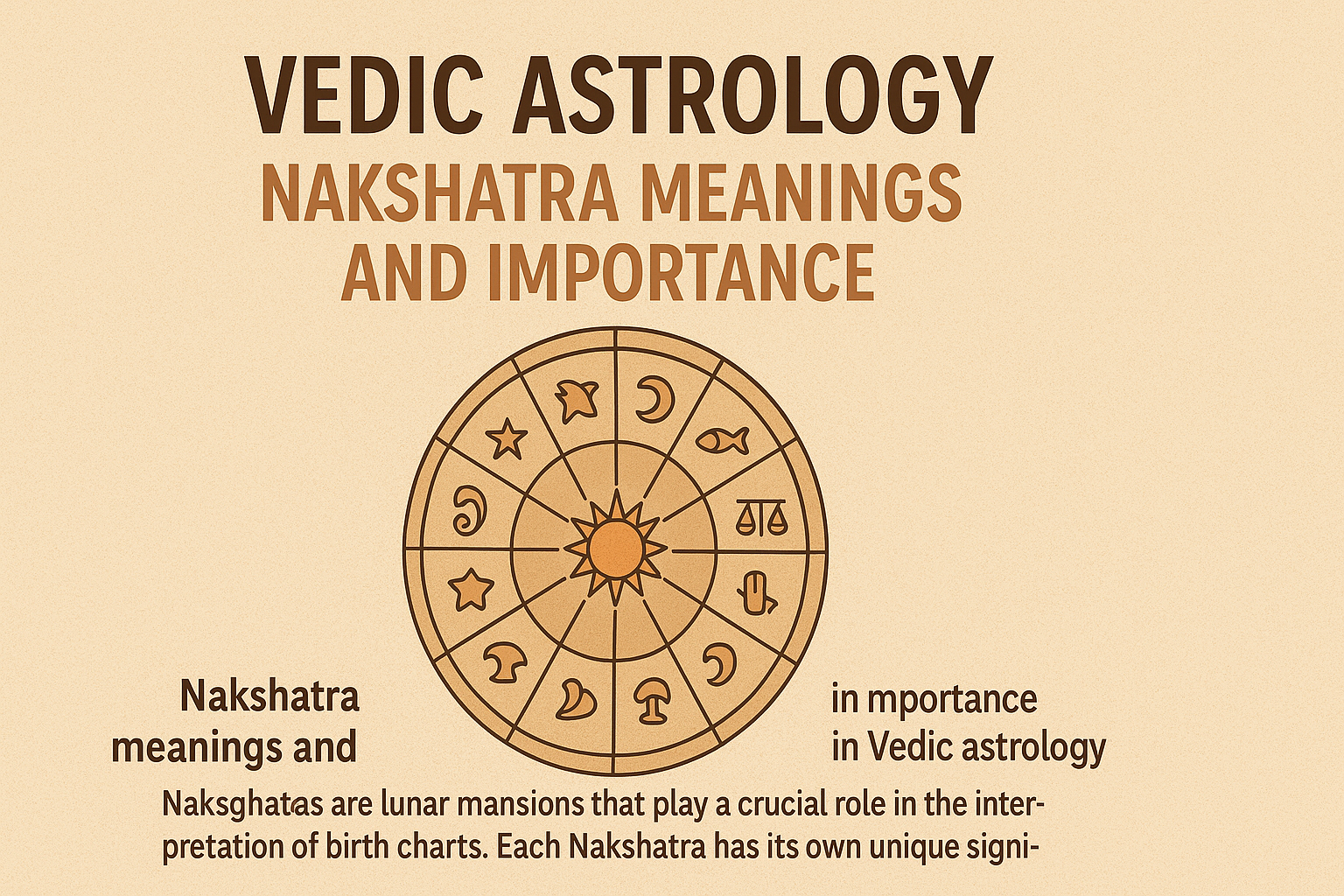Vedic Astrology Nakshatra Meanings and Importance

Need Guidance On Your Problems?
Consult With The Best Online Astrologers
In the ancient cosmic science of Vedic astrology, Nakshatras hold a profound and foundational significance. Known as lunar mansions or constellations, Nakshatras divide the sky into 27 segments, each representing a unique cosmic energy and influence. The Moon’s position within a specific Nakshatra at the time of a person's birth shapes their personality, emotions, and destiny. Understanding Nakshatras offers key insights into one’s nature, karmic patterns, and life journey.
What Are Nakshatras?
The word Nakshatra is derived from two Sanskrit words: "Naksha," meaning map, and "Tara," meaning star. Together, Nakshatra means a star map or lunar mansion. Each Nakshatra spans approximately 13 degrees and 20 minutes of the zodiac. Unlike the 12 broader zodiac signs, these 27 Nakshatras provide a more detailed lens into one’s celestial blueprint.
Nakshatras are often described as the 27 daughters of Prajapati Daksha, and the Moon is considered their husband. It spends about one day in each Nakshatra during its 27.3-day orbit around the Earth. This nightly journey signifies a powerful rhythm that influences human emotions and life cycles.
Importance of Nakshatras in Vedic Astrology
Nakshatras are essential in Vedic astrology because they:
-
Define deep psychological and emotional traits not captured by the sun sign alone.
-
Influence the placement and strength of the planets in a birth chart, thus shaping destiny.
-
Determine auspicious timings for rituals, business decisions, and marriage compatibility.
-
Help predict life events through their role in dashas (planetary periods).
-
Provide guidelines for Vedic astrology remedies to harmonize karmic challenges.
Each Nakshatra is ruled by a planet, which further modifies its characteristics. For instance, Krittika is ruled by the Sun, influencing leadership and power, while Rohini is ruled by the Moon, symbolizing nourishment and creativity.
Nakshatra’s Role in Career and Life Decisions
Studying the Nakshatra of the Moon and key planets in a person's chart helps in Vedic astrology for career advice. Certain Nakshatras are associated with leadership, creativity, or technical skills. For example:
-
Ashwini Nakshatra represents swift action and healing—ideal for medical or emergency service careers.
-
Bharani Nakshatra signifies nurturing energy, suited for caregiving professions.
-
Pushya Nakshatra symbolizes growth and support, often linked with education and counseling careers.
By analyzing the Nakshatras influencing the 10th house (career house) and its lord, astrologers can guide individuals toward fulfilling professional paths aligned with their cosmic strengths.
Influence of Nakshatras on Planets
In Vedic astrology planets transit through different Nakshatras, which affects how their energies manifest. The quality and strength of a planet depend on the Nakshatra it occupies. For instance, Jupiter in Punarvasu Nakshatra brings optimism and wisdom, while Saturn in Shravan Nakshatra emphasizes discipline and patience.
Understanding these nuances allows astrologers to provide precise predictions and remedies tailored to the individual’s chart.
What are the key planets involved in Nakshatra analysis
The key planets involved in Nakshatra analysis in Vedic astrology are the ruling planets of each of the 27 Nakshatras. Each Nakshatra is governed by a unique planet that imparts specific energies and influences its traits and effects on a person's birth chart. Understanding these planetary rulers is essential for interpreting the characteristics of Nakshatras and their impact on life.
Here is an overview of the key planets as rulers of Nakshatras:
-
Ketu: Rules Ashwini, Magha, and Mula Nakshatras
-
Venus: Rules Bharani, Purva Phalguni, and Purva Ashadha Nakshatras
-
Sun: Rules Krittika and Uttara Phalguni Nakshatras
-
Moon: Rules Rohini, Hasta, and Shravana Nakshatras
-
Mars: Rules Mrigashira, Chitra, and Dhanishta Nakshatras
-
Rahu: Rules Ardra, Swati, and Shatabhisha Nakshatras
-
Jupiter: Rules Punarvasu, Vishakha, and Purva Bhadrapada Nakshatras
-
Saturn: Rules Pushya, Anuradha, and Uttara Bhadrapada Nakshatras
-
Mercury: Rules Ashlesha, Jyeshtha, and Revati Nakshatras
These ruling planets shape the themes and energies of the Nakshatras through their qualities and cosmic functions. For example, Mars adds dynamism and courage, while the Moon brings nurturing and emotional depth.
In Nakshatra analysis, the position, strength, and aspect of these vedic astrology planets within a birth chart help an astrologer interpret personality traits, strengths, challenges, and life events associated with the lunar mansion energy of the native.
Understanding which planet governs a Nakshatra, along with the Nakshatra’s deity and symbolism, is vital to a comprehensive analysis in Vedic astrology.
This planetary association also guides specific vedic astrology remedies by aligning suitable rituals, mantras, or gemstones with the ruling planet’s energy to harmonize influences.
Thus, the key planets involved in Nakshatra analysis are central players in unlocking the profound wisdom and guidance offered by this ancient astrological system.
Vedic Astrology Remedies Linked to Nakshatras
When challenges arise due to planetary influences within certain Nakshatras, specific remedies can be prescribed. These include:
-
Wearing gemstones associated with the ruling planet of the Nakshatra.
-
Chanting mantras dedicated to the Nakshatra deity.
-
Performing rituals or pujas on auspicious Nakshatra days to enhance positive effects.
-
Offering charity or engaging in acts of kindness related to the Nakshatra’s qualities.
These Vedic astrology remedies help reduce negative influences and promote well-being.
Conclusion
Nakshatras form a vital aspect of Vedic astrology that goes beyond sun signs to provide a deeper understanding of one’s cosmic framework. Their unique characteristics govern emotions, aptitudes, and life patterns, especially influencing vedic astrology for career and overall life strategies. The interplay of vedic astrology planets within these lunar mansions offers rich interpretative insights, enabling personalized advice and potent Vedic astrology remedies to harmonize fate and free will.
By leveraging Nakshatra knowledge, seekers can align their lives with cosmic rhythms, unlocking potential and achieving balance on their spiritual and earthly journey

